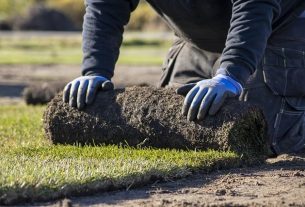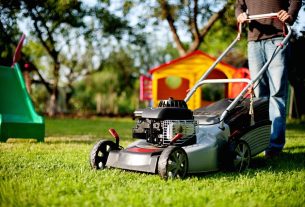To maintain a healthy, vibrant lawn that withstands environmental stressors, it's crucial to select grass varieties suited to your regional climate and soil conditions. Regular aeration and overseeding promote soil health and a dense, resilient turf. Landscaping, incorporating trees, shrubs, and garden beds, not only enhances the aesthetic appeal but also helps shape local microclimates, offering protection and supporting the lawn's ecosystem. Mulching these areas conserves moisture and suppresses weeds. An efficient irrigation system tailored to your lawn's needs ensures optimal water usage. Strategic fertilization aligned with grass growth cycles encourages strong roots and lush foliage. A comprehensive lawn care and landscaping approach, informed by local environmental factors, results in an ecologically sound outdoor space that is both beautiful and low-maintenance. For a successful landscaping project, detailed planning and professional advice are key, along with consistent maintenance to sustain the beauty and health of your landscape over time. By combining these practices with organic methods, you can create a thriving, sustainable outdoor environment that provides lasting enjoyment.
Embark on a journey through the verdant realm of landscaping design, where lush lawns and thoughtfully arranged elements transform ordinary outdoor spaces into extraordinary sanctuaries. This article delves into the artistry of lawn care and strategic planning in landscaping to illuminate how you can cultivate a thriving yard that reflects both beauty and functionality. Discover the essential elements for effective lawn maintenance, learn about execution techniques and maintenance tips to bring your landscaping vision to life, and understand how these practices contribute to the overall health and aesthetic of your outdoor environment. Enhance your living space with insights on Lawn Care and Landscaping that will inspire and guide you towards achieving the perfect balance between nature and design.
- Essential Elements of Effective Lawn Care for a Thriving Yard
- Strategic Planning in Landscaping Design to Enhance Your Outdoor Space
- Implementing Your Landscaping Vision: Execution Techniques and Maintenance Tips
Essential Elements of Effective Lawn Care for a Thriving Yard

A thriving yard is a reflection of meticulous lawn care practices complemented by thoughtful landscaping design. Effective lawn care begins with understanding the local soil conditions and choosing grass varieties that are well-suited to the climate and light availability in your region. Selecting the right grass type ensures that your lawn can withstand environmental challenges, from drought to pests, while maintaining a lush appearance. Regular aeration and overseeding are key practices to maintain soil health and promote dense turf growth, allowing roots to reach nutrients and water effectively.
In addition to the selection of grass types and regular maintenance, landscaping elements such as strategic placement of shrubs, trees, and garden beds can enhance your lawn’s resilience. These elements create a microclimate that can protect your grass from harsh winds, excessive shade, or overly sunny conditions. Mulching around these plants helps to retain soil moisture and suppress weeds, further contributing to the health of your lawn. A robust irrigation system tailored to your lawn’s needs ensures consistent watering without waste. Fertilization should be balanced and timed according to the growth patterns of your grass, promoting a vigorous root system and lush foliage. By integrating these essential elements into your lawn care routine and landscaping design, you can achieve a yard that is both aesthetically pleasing and environmentally sustainable.
Strategic Planning in Landscaping Design to Enhance Your Outdoor Space

Embarking on a landscaping project involves thoughtful strategic planning to transform your outdoor space into a visually appealing and functional area. A well-designed landscape not only elevates the aesthetic value of your property but also integrates lawn care practices that promote a healthy, vibrant lawn. Central to this process is assessing the unique conditions of your outdoor environment, such as soil type, sunlight exposure, and local climate, to select plants and grasses that thrive in these specific conditions. This approach not only ensures long-term success but also reduces the need for excessive maintenance, which is both time-saving and cost-effective.
Incorporating elements like hardscaping, such as walkways or water features, can complement the natural beauty of your yard while providing practical benefits. Strategic placement of these elements should consider ease of movement through the space, visual flow, and the integration of lawn care routines for maintenance. For instance, placing a water feature near an irrigation system’s source can simplify watering needs. By thoughtfully integrating both organic and inorganic materials, your landscape design becomes a cohesive unit that harmonizes with the surrounding environment, and lawn care and landscaping efforts become more streamlined and impactful. Attention to detail and long-term vision are key components of successful strategic planning in landscaping design, ensuring that your outdoor space is both beautiful and sustainable over time.
Implementing Your Landscaping Vision: Execution Techniques and Maintenance Tips

Embarking on a landscaping project requires careful planning and execution to bring your vision to life. To successfully implement your design, it’s crucial to start with a clear plan that includes a detailed timeline and budget. Engage with reputable lawn care and landscaping professionals who can offer expert advice tailored to your local climate and soil conditions. Their insights will guide the selection of plants, trees, and grass varieties that thrive in your region, ensuring a lush and vibrant landscape all year round.
Once the foundational elements are in place, shift your focus to the finer aspects of landscaping. This includes the precise layout of garden beds, the installation of irrigation systems, and the placement of outdoor features such as decks or water features. Regular maintenance is key to maintaining the health and beauty of your landscape. Develop a routine for tasks like mowing, fertilizing, pruning, and weeding. Employ organic lawn care practices to promote soil health and reduce the environmental impact. Consistent upkeep will not only preserve the aesthetic appeal but also extend the lifespan of your landscaping investments. Remember to adapt your maintenance schedule to seasonal changes and climate-specific challenges, ensuring your outdoor space remains a point of pride and tranquility for years to come.
Effective lawn care and thoughtful landscaping design are integral components in creating a vibrant outdoor space. This article has explored the essential elements of lawn care that contribute to a thriving yard, offered strategic planning advice for landscape design, and provided execution techniques and maintenance tips to bring your vision to life. By understanding and applying these principles, you can transform your property into an aesthetically pleasing environment that offers both beauty and functionality. Remember, with the right approach to lawn care and landscaping, anyone can achieve a flourishing outdoor oasis.



